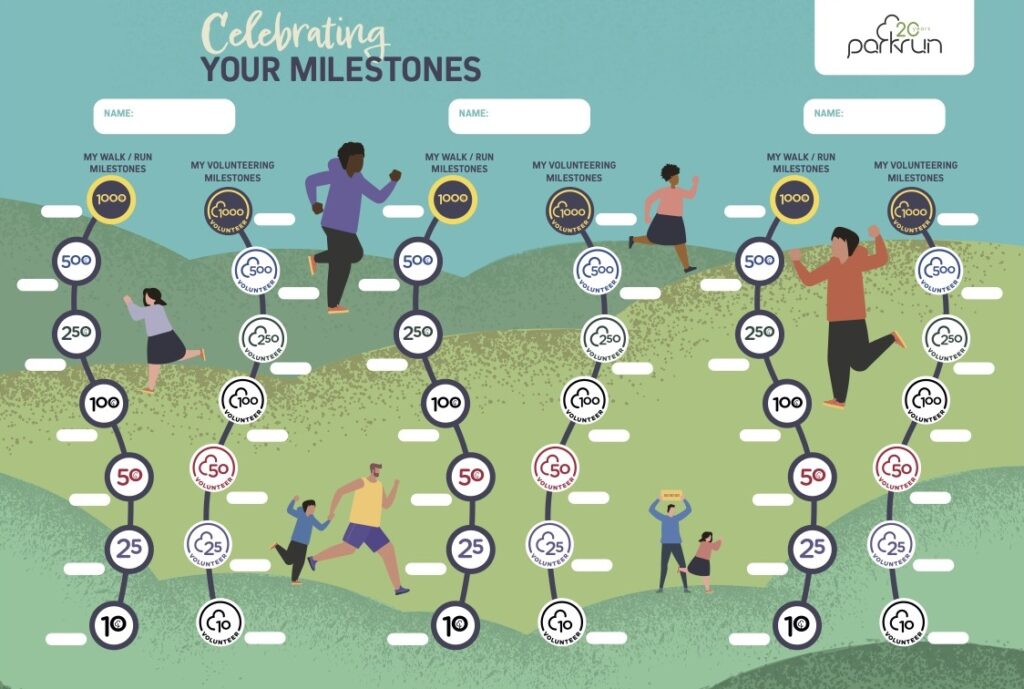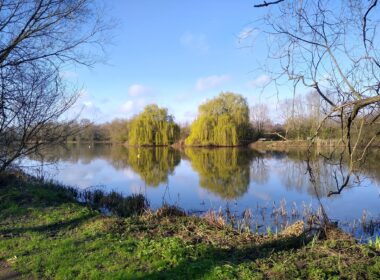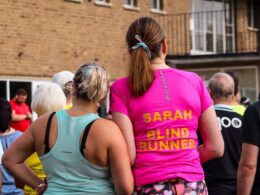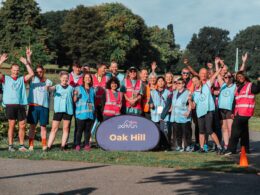The idea behind parkrun was incredibly simple. So simple, in fact, that founder Paul Sinton-Hewitt was able to set it up while holding down a full-time job and raising a young family. Yet from that tiny initial seed, a charity with branches around the world has emerged. Twenty years after the first event, parkrun is on a mission to create social change, to make the world a better place. We look at what parkrun has achieved and what is needed to further the mission going forward.
Paul Sinton-Hewitt is not a man who likes to take the credit. Especially when he thinks that other people have played just as important a role in the history of parkrun as he has. Yet it remains the case that without Paul, parkrun simply wouldn’t exist. It’s thanks to his grit and determination that millions of people are able to enjoy parkrun today. And many more will go on to have their lives changed by parkrun.
But to return to the beginning: Paul instigated that first event because, recovering from an injury, he was really missing running with his friends: “The release that I typically had prior to the injury,” he explains, “was going to my running club on a Thursday night, doing an event on the weekend, meeting with running pals.”
That release was crucial to his wellbeing and without it, with the pressure of work and a young family, Paul found his mental health was suffering. So he simply invited a few of his running friends to meet in Bushy Park, Teddington on 2 October 2004, for a timed 5km run. What was to be the first ever Bushy Park Time Trial (which eventually changed its name to parkrun) had a total of 13 runners, joined by five volunteers – Paul and his wife Joanne, Duncan Gaskell, Simon Hedger and Robin Drummond. They used pen and paper to record the results and washers from a local hardware store for finish tokens. And for two years, that’s all there was: a weekly meet-up in Bushy Park. But one of Paul’s friends – Jim Desmond – kept urging him to set up another event. Due to the growing popularity of the Bushy Park event, Jim saw that adding another event was necessary. Eventually, Paul relented and a second event was launched on Wimbledon Common in 2006. By the end of 2007, another five events had been added.
Even in the earliest days, there were signs of just how impactful parkrun would be. Paul recalls an encounter early in parkrun’s history: “A gentleman came up to me. He took me aside and he said, ‘This is life changing.’ And that was the first time anyone had said that.” Many had said how brilliant it was, how he should set up more events. But “life changing”? That was new.

“In the beginning, I did speak about community,” Paul recalls. “I did speak about well-being. I spoke about health. I spoke about all those sorts of things.” But in terms of understanding the impact parkrun could have on social issues, on the bigger picture, that shift came in 2015. Paul was busy growing parkrun as an organisation, and recruited Nick Pearson to join as Chief Executive Officer (CEO). As Paul handed over the reins, the new CEO understood that, in order to fulfil its potential, the leadership team needed to take charge of where parkrun was headed. According to Paul, Nick told him, “Your mission is laudable, but actually it has no direction. It’s just more of the same thing. You need clarity in your mission and your purpose.” That mission was to transform health and happiness. To empower people to come together, to be active, to be social and to get outdoors. Without barriers. And with the new-found clarity came an understanding of the opportunities that really aligned with parkrun’s values.
In the years since, parkrun’s leadership team have focused on the mission, huge leaps have been taken in achieving social change. parkrun has developed partnerships with the Royal College of General Practitioners to promote social prescribing of parkrun for people with physical and mental health issues. The number of parkruns in prisons has increased thanks to the collaboration with His Majesty’s Prisons and Probation Service. parkrun is striving to ensure all volunteers have a world class experience, from those who simply turn up on the day, through to the dedicated event directors, teams and ambassadors, with a significant recent investment in this area. And a recent razor-sharp focus on the growth of junior parkrun has seen record breaking numbers across the Sunday 2k series, bringing fun and activity to thousands of children and their families. You can read more about that on p49. But how is all this possible?
One way is that in 2018, parkrun changed its status from a not-for-profit organisation to that of a UK charity. There were many good reasons for doing this – one being the transparency that comes with being a charity. Russ Jefferys, current CEO of parkrun, picks up the story. “Before parkrun became a charity, the message to parkrunners was to simply enjoy the Saturday and Sunday events, and not to worry about the logistics” But as the number of events continued to grow, and the real impact of the movement began to be truly understood, allowing everyone to see what parkrun spends its money on became an important aim in itself, as well as giving people the opportunity to support parkrun themselves.
Recent analysis suggests that each and every week it costs more than £200,000 to safely deliver parkrun, for the hundreds of thousands that take part. It’s still incredibly cost efficient, and scalable, and it will always be free to participate. But it isn’t free to deliver.
For Russ, the most important message to get across is that “it is crucial that parkrun remains free, for everyone, forever”. And that will never change. But with the rapid growth of parkrun, has come increased pressure on our resources. We must continue to futureproof the infrastructure of parkrun; that’s everything from technology, to risk management, to insurance, safeguarding, results processing and the support of our vital volunteer teams on the ground. That’s before we look at further unlocking the potential of parkrun, the global expansion, and the diversification of participation through collaborative outreach programmes. We will not stop until everyone has the opportunity to take part in free physical activity in their local communities, without barriers. And we must work together to achieve that goal.
parkrun is really proud of its charity status; of its position as an organisation that saves and changes millions of lives. For so many it is a lifeline, not a running event, and it’s important we continue reinforcing that message. Not only so that people can find the right way to support us, if they can and are able, but so that we are truly understood as the huge global force for good that we aspire to be.
To find out more about the history of parkrun, the organisation’s work as a charity, governance, and ways to give please, visit parkrun.com.
20 Years at a Glance:

with quotes by Paul Sinton-Hewitt CBE, parkrun Founder.
2004 – the first event in Bushy Park, the Bushy Park Time Trial.
2007 – parkrun goes from a single event to seven in a year.
The ability to run simultaneous events is proved at Wimbledon and quickly evolves to Richmond, Banstead, Leeds (the first event outside of London) and Brighton. The first person to hit the 100 milestone at the 125th event in Bushy Park.
“Darren Wood was the first person to reach 100 parkruns and it seemed the right thing to do to commemorate the milestone. We presented him with a black fleece and really that was the start of the official milestones we know and love today.”
2008 – five more events.
Five more new events are launched along with the first Scottish and Welsh events in Glasgow and Cardiff. The name changes from UK Time Trials to parkrun.
2009 – first event in Denmark.
The first event in Denmark is held in May and another 15 new parkrun events go live. 112,260 finishes recorded this year. Did you know: The first international parkrun was in Zimbabwe, however, Copenhagen was the first international parkrun that’s still in existence today.
2010 – junior parkrun started in Bushy Park; mandatory barcodes are introduced.
Up until this point, parkrunners would simply finish and take their token up to a volunteer who was sitting at a table with a laptop. Finishers would give their name to volunteers who would look the person up on the database and assign the result.
2012 – 90 new events, including in New Zealand, USA and Ireland. And a whopping 992,308 finishes recorded!
2017 – custodial events (parkruns in prisons) are introduced with Black Combe parkrun at HMP Haverigg. Tail walkers were made mandatory at parkrun events.
“We welcomed people to walk at parkrun, to take as long as they liked to complete the course, but our insight told us that people were afraid of coming last. By making sure that every event had a tail walker who would finish last we removed that barrier to participation.“
2018 – parkrun practice started.
The parkrun practice initiative starts in June with the Royal College of General Practitioners (RCGP). parkrun events partner with local GP practices to encourage doctors and healthcare professionals to prescribe parkrun to patients and staff in order to improve health and wellbeing.
2020 – the global pandemic means parkrun events are paused around the world. A number of initiatives are started – to continue to try to make the world happier and healthier.
2024 – 10 million registered parkrunners.
“Wow! What a milestone! And what a year to celebrate it – along with our 20th anniversary. I never dreamed we’d get there, I hoped that we would – but seeing it – it’s just phenomenal. And we’re only just beginning!”









